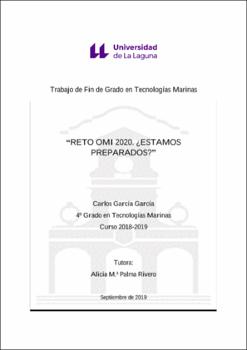Reto OMI 2020: ¿estamos preparados??
Autor
Garcia Garcia, CarlosFecha
2020Resumen
Hoy en día, nos encontramos con una problemática mundial debido a la polución y
contaminación atmosférica que afecta directamente al ecosistema y población de La
Tierra. Uno de los mayores culpables de estos acontecimientos es el azufre que se
encuentra oculto en muchos de los combustibles que utilizamos diariamente y es
expulsado a la atmósfera en forma de dióxido de azufre que en contacto con el agua forma
ácidos generando la conocida “lluvia ácida”.
Uno de los principales causantes de emisiones de azufre son los buques, que, aunque en
relación emisiones/toneladas transportadas por km, con una eficiencia relativa notable
por encima del transporte aéreo e incluso terrestre (tren), siguen emitiendo a la atmósfera
grandes cantidades de este contaminante.
Por los motivos expuestos anteriormente, desde el año 2005 la OMI (Organización
Marítima Internacional) en virtud del Anexo VI del Convenio MARPOL (Convenio
Internacional para prevenir la contaminación por los buques), establece unos límites
superiores de azufre en los combustibles utilizados por los buques cada vez más estrictos.
Este trabajo tiene por objeto conocer dicha normativa y adecuación de las navieras para
cumplir con las restricciones establecidas de próxima implantación el 01 de enero de
2020. Así como, conocer alternativas de cara al futuro que puedan sustituir por completo
o de manera parcial el consumo de hidrocarburos. Today, we are faced with a global problema due to pollution and atmospheric pollution
that directly affects the acosystem and population of The Earth. One of the major culprits
of these events is the sulphur that is hidden in many of the fuels that we use dialy andis
expelled into the atmosphere in the form of sulphur dioxide that in contact with water
forms acids generating well-known “lluvia ácida”.
One of the main causes of sulphur emissions are ships, which, although in terms of
emissions per tonne transported per km, with anotable relative efficiency above air and
evenland (train) transport, continue to emit large quantities of this pollutant into the
atmosphere.
Fort he reasons set out above, since 2005 the IMO (International Maritime Organisation)
under Annex VI of the MARPOL Convention (International Convention for the
Prevention of Pollution from Ships), has been setting higher sulphur limits for fuels used
by increasingly stringent ships.
The aim of this work is to get to know these regulations and the adequacy of the shipping
companies to comply with the restrictions established for the next implementation on 01
January 2020. As well as, to know alternatives for the future that can replace completely
or partially the consumption of hydrocarbons





